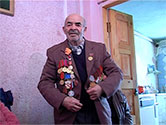
Lev Kolodenker is the brother of Pesia and Aleksandr Kolodenker and husband of Yente Kolodenko, nee Tolkovitz. He was born in Tulchyn in 1925. His father was a coachman and he worked in the Tulchyn shoe factory at the age of fifteen. In 1941, at the age of sixteen, he was drafted into a military training institute, and joined the Red Army in 1944, where he rose to the rank of sergeant. After the war, he worked as truck driver and then again as shoemaker for thirty-five years.
Other Interviews:
Army TrainingFrom Tulchyn to Pechera
Tulchyn, Ukraine
In December 1941, the Jews of Tulchyn, who had been languishing in the city’s ghetto for the first months of the war, were ordered to report for disinfection and relocation. A typhus epidemic was spreading through Transnistria—the region of Ukraine under Romanian occupation. Romanian authorities panicked at the typhus epidemic of late 1941, and, in some regions where the epidemic was already rampant, responded with extreme violence: in the last weeks of 1941 and first months of 1942, some 48,000 Jewish prisoners, mostly deportees from Bessarabia and Bukovina, were massacred in camps set up in Bogdanovka and Domanevka, in the Golta region of the southeastern part of Transnistria. The authorities justified the massacre as a means of preventing the spread of the disease and of protecting supply lines to the north. The massacre was also the culmination of a eugenics and purification mentality that had pervaded Romanian political and social thought.
The Jews of Tulchyn were gathered together and counted in a local school, where they were held for three days without food or water-- "packed together like sardines" in the words of one survivor. Afterwards, the 3,005 Jews of Tulchyn were taken to the city’s baths to be disinfected.
The Jews of Tulchyn were then forcibly marched through the town along the village road. They passed through the village of Torkiv, where they were housed in stables and the first victims perished. Those unable to walk were shot and left to die on the road.
The convoy eventually arrived in the town of Pechera, where, set on a cliff overlooking the Southern Bug River and surrounded by parkland was a three-story Romanesque palace that had once belonged to the Potocki noble family, but had been used as a sanatorium for tuberculosis patients by the Soviet government. It was an ideal isolation ward for quarantine purposes.
The Jews of Tulchyn and surrounding towns were dumped in the building and left to their own devices. This was not a labor camp nor technically a death camp—although death rates were exceedingly high. Rather, it was simply a de facto concentration camp, a place where the Romanians could quarantine Jews to prevent the typhus epidemic from spreading.
Over the course of the next months, additional shipments of Jews were brought into the camp, including about 750 Jews from Bratslav who were brought to the camp in January 1942, and several hundred more who arrived over the next few days from Ladyzhyn and Vapnyarka. Sporadic deportations into Pechera continued over the summer and fall: about 3,500 Jews from the Mohyliv-Podilskyy ghetto were deported to Pechera in two waves in July and October–November 1942. Many inmates of the camp were Bessarabian and Bukovinian Jews, whose long forced exodus from their homes in Romania finally ended here. In total about 9,000 Jews were held in Pechera.
In this clip, Lev Kolodenker talks about the ordeal endured by the Jews of Tulchyn and relates some of their experiences in the Pechera camp.
Source: Jeffrey Veidlinger, In the Shadow of the Shtetl: Small-Town Jewish Life in Soviet Ukraine (Indiana University Press, 2013)
